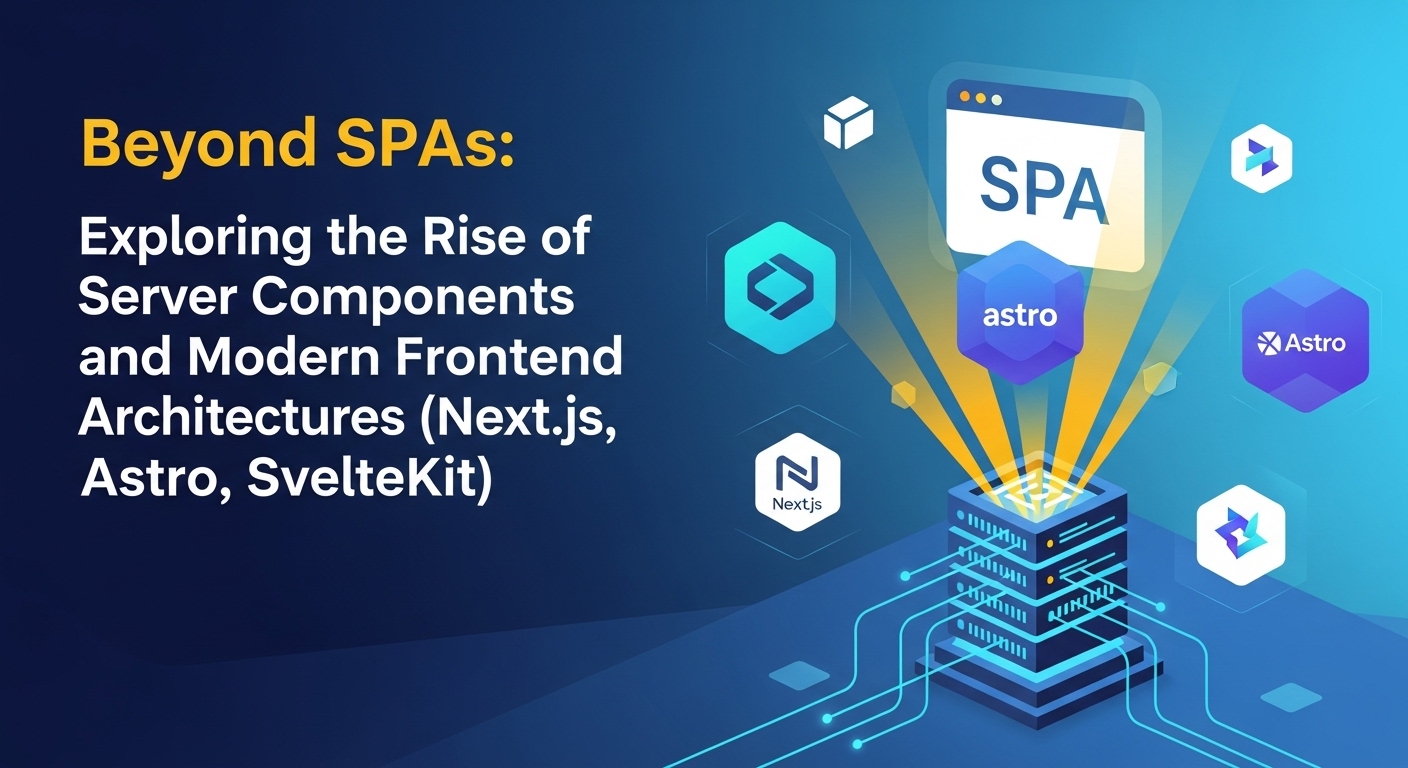What Are Micro-Frontends, Really?
For years, the world of frontend development has been dominated by monolithic architectures. We build large, single-page applications (SPAs) where every feature, every component, and every line of code is bundled into a single, massive codebase. While this approach works for smaller projects, it starts to crack under the pressure of scale. As teams grow and applications become more complex, the monolith can turn into a bottleneck, slowing down development, complicating deployments, and making technology upgrades a nightmare.
Enter micro-frontends. Inspired by the microservices revolution on the backend, this architectural style takes a different approach. Instead of one giant application, you compose your user interface from a collection of smaller, independent, and loosely coupled applications. Think of it like building with LEGOs. Each team can own a specific piece of the UI (a ‘micro-frontend’), like the search bar, the product recommendation engine, or the user profile page. They can build, test, and deploy their piece independently of everyone else.
Breaking Down the Monolith
The core idea is to slice a web application vertically by business domain or feature, rather than horizontally by technical layers (like UI, business logic, database). In a traditional monolith, you might have a ‘UI team’ and a ‘backend team’. With micro-frontends, you have a ‘search team’ or a ‘checkout team’ that owns their feature end-to-end, from the database all the way to the pixels rendered in the browser. This fosters a sense of ownership and expertise that is often lost in larger, more generalized structures.
This decomposition allows for a more manageable and scalable approach to frontend development. When a bug is found in the shopping cart, only the ‘cart team’ needs to deploy a fix. When the ‘product details’ team wants to upgrade to the latest version of React, they can do so without forcing the entire organization to coordinate a massive, high-risk migration.
Core Principles of Micro-Frontends
To truly grasp the concept, it’s helpful to understand the guiding principles:
- Technology Agnostic: Each team should be able to choose their own tech stack. One team might use React, another Vue, and a third Angular, all coexisting peacefully within the same application.
- Team-Owned Code: A single, autonomous team should own their micro-frontend from conception to production. This includes development, testing, deployment, and maintenance.
- Isolated Codebases: Each micro-frontend should live in its own repository, with its own build process and deployment pipeline.
- Independent Deployment: The ability to deploy a micro-frontend without having to coordinate with other teams is a cornerstone of this architecture.
- Favor Native Browser Features: Use browser events for communication and web components for integration to avoid creating custom, brittle APIs between your frontends.
Why is Everyone Talking About Micro-Frontends Now? The Benefits
The buzz around micro-frontends isn’t just hype; it’s a direct response to the growing pains of large-scale frontend development. Organizations are realizing that the old ways of building UIs aren’t sustainable for complex, long-lived applications. Here are the key benefits driving their adoption.
Independent Teams, Faster Development
This is arguably the biggest win. When teams are autonomous, they can move faster. They aren’t blocked waiting for another team to finish a feature or for a coordinated ‘release train’. They can iterate quickly, experiment with new ideas, and deliver value to users more frequently. This organizational decoupling is a powerful catalyst for innovation and speed.
Technology Agnosticism: Mix and Match Frameworks
Imagine being stuck with an outdated version of a framework because upgrading the entire application is too risky or time-consuming. Micro-frontends solve this. New features can be built with modern tools, while older, legacy parts of the application can be incrementally rewritten or replaced over time. This allows your application to evolve gracefully, preventing the dreaded ‘big bang’ rewrite that plagues so many projects.
Improved Scalability and Resilience
Micro-frontends offer scalability on two fronts: organizational and technical. You can scale your organization by adding more independent teams without them stepping on each other’s toes. Technically, the application becomes more resilient. If one micro-frontend fails or has a critical bug, it doesn’t necessarily bring down the entire application. The rest of the UI can continue to function, providing a degraded but still usable experience for the user.
Easier Maintenance and Upgrades
Smaller, more focused codebases are simply easier to understand, maintain, and debug. When a developer joins a team, they only need to get up to speed on a small slice of the application, not the entire monolithic beast. This significantly reduces cognitive load and onboarding time. As mentioned, upgrades become localized, low-risk events rather than all-hands-on-deck emergencies.
Common Challenges and How to Overcome Them
While the benefits are compelling, adopting a micro-frontend architecture is not a silver bullet. It introduces its own set of complexities that need careful consideration.
Navigating Complexity and Orchestration
You’ve traded one big application for many small ones, but now you need something to orchestrate them. This ‘application shell’ or ‘container’ is responsible for loading the different micro-frontends, handling routing, and managing shared state. Deciding how this shell works is a critical architectural decision.
Ensuring a Consistent User Experience (UX)
With multiple teams building different parts of the UI, how do you ensure it all looks and feels like a single, cohesive product? The answer is a robust design system and shared component libraries. Teams should consume a centralized library of UI components (buttons, forms, modals) to maintain visual and interactive consistency across the entire user journey.
Managing Shared Dependencies and State
What happens when multiple micro-frontends need to know if a user is logged in? Sharing state is a classic challenge. Solutions range from using custom browser events and web storage to more sophisticated state management libraries designed for distributed systems. Similarly, managing shared library dependencies (like React or Lodash) can be tricky. If every micro-frontend bundles its own copy, your application’s payload size can skyrocket. Tools like Webpack’s Module Federation are designed specifically to solve this problem by allowing micro-frontends to share dependencies at runtime.
Popular Approaches to Implementing Micro-Frontends
There are several ways to stitch your micro-frontends together into a cohesive whole. The right choice depends on your specific needs and technical context.
Build-Time Integration
This is the simplest approach. You treat each micro-frontend as an NPM package. The container application lists them as dependencies and they are all bundled together at build time. While easy to set up, this approach sacrifices the key benefit of independent deployment.
Server-Side Integration
Using techniques like Server-Side Includes (SSI), the web server can compose a page from different HTML fragments served by your micro-frontend applications. This is a very robust and resilient method, but it can feel a bit old-school in the modern SPA era.
Runtime Integration via iframes
Iframes provide the ultimate level of isolation. Each micro-frontend lives inside an iframe, completely sandboxed from the others. This makes security and styling simple, but communication between them can be clunky, and they can present challenges for responsive design and deep linking.
Runtime Integration via JavaScript
This is the most popular and flexible approach in modern frontend development. The container application uses JavaScript to dynamically load the scripts for each micro-frontend when they are needed. Webpack’s Module Federation is the current state-of-the-art technology for this, allowing different, independently deployed applications to share code and dependencies in the browser at runtime.
Is This Architecture Right for Your Project?
Before you jump on the bandwagon, it’s crucial to evaluate if this architectural pattern fits your context. It’s a powerful tool, but it’s not for everyone.
When to Consider Micro-Frontends
- You have a large, complex application that is becoming difficult to maintain.
- You have multiple teams working on the same frontend codebase and they are frequently blocking each other.
- You want to incrementally upgrade or rewrite parts of a legacy application without a full rewrite.
- Your application is composed of distinct business domains that can be developed and deployed independently.
When to Stick with a Monolith
- You have a small to medium-sized application.
- You have a single, small development team.
- The application’s features are highly coupled and don’t have clear domain boundaries.
- Your team is not yet comfortable with the complexities of distributed systems.
Conclusion: Embrace the Future of Frontend Development
Micro-frontends represent a significant shift in how we think about and build web applications. They are not a magic solution, but a strategic architectural choice that trades the simplicity of a monolith for the long-term scalability, flexibility, and team autonomy required by large, complex projects. By breaking down our UIs into smaller, manageable pieces, we empower our teams to move faster, innovate more freely, and build more resilient and maintainable products. As the demands on frontend development continue to grow, embracing patterns like micro-frontends will be essential for any organization looking to scale effectively. Are you ready to start your journey?


